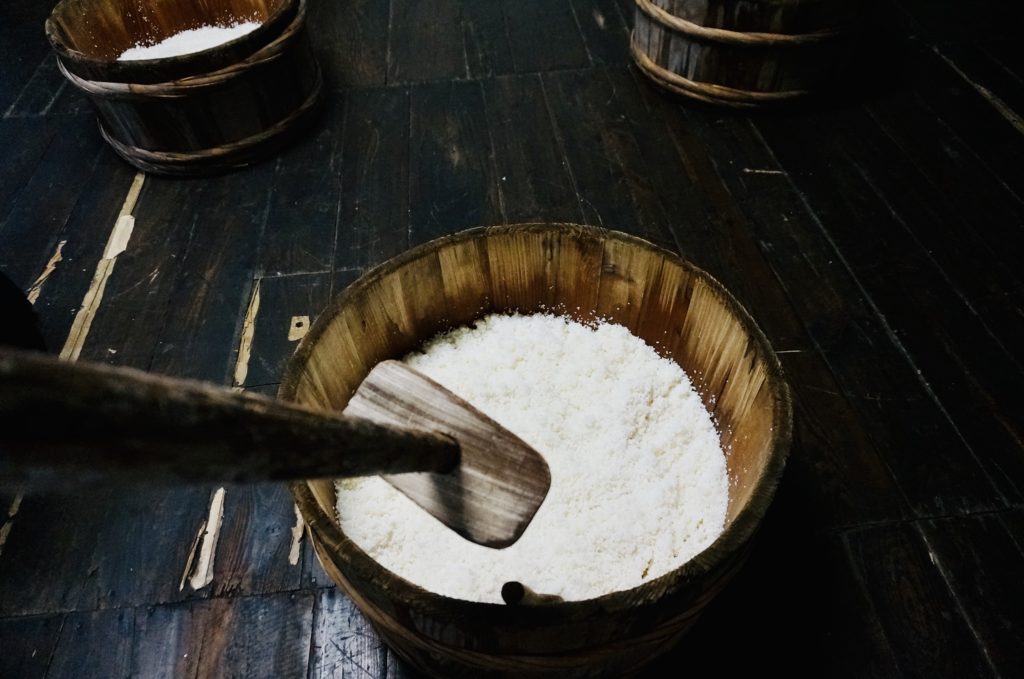
Written by Keita Okubo
Translated by Saki Kimura
“Kimoto” is the classic method of sake brewing in the Edo period. This is a traditional method of incorporating natural bacteria and microorganisms for the fermentation. The highlight of the process (or rather, the easiest way to understand it) is “Yamaoroshi,” in which steamed rice, koji rice, and water in a barrel are scrubbed with wooden paddles.
We were invited by the owner of Jizake-ya Kodama, a local sake store in Otsuka, to participate in the process of Yamaoroshi at the Syoki Brewery in Nagano Pref.!
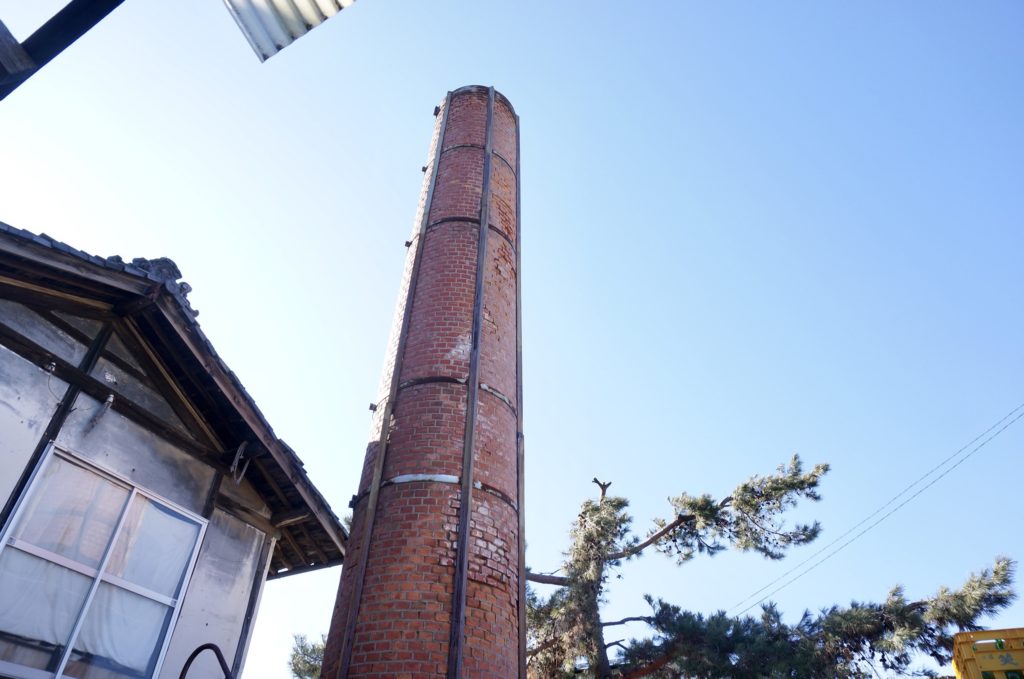
Syoki Brewery was founded in 1883. “Syoki” and “Kikon” are their signature brands.
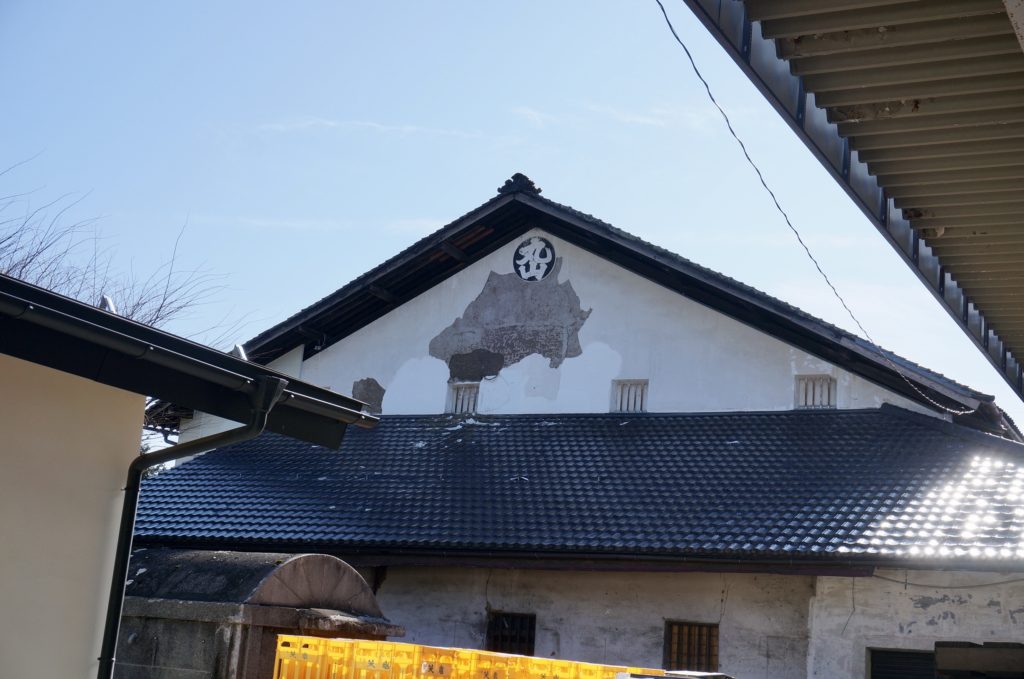
This is the exterior of the brewery. A part of the wall was ripped off by a typhoon.
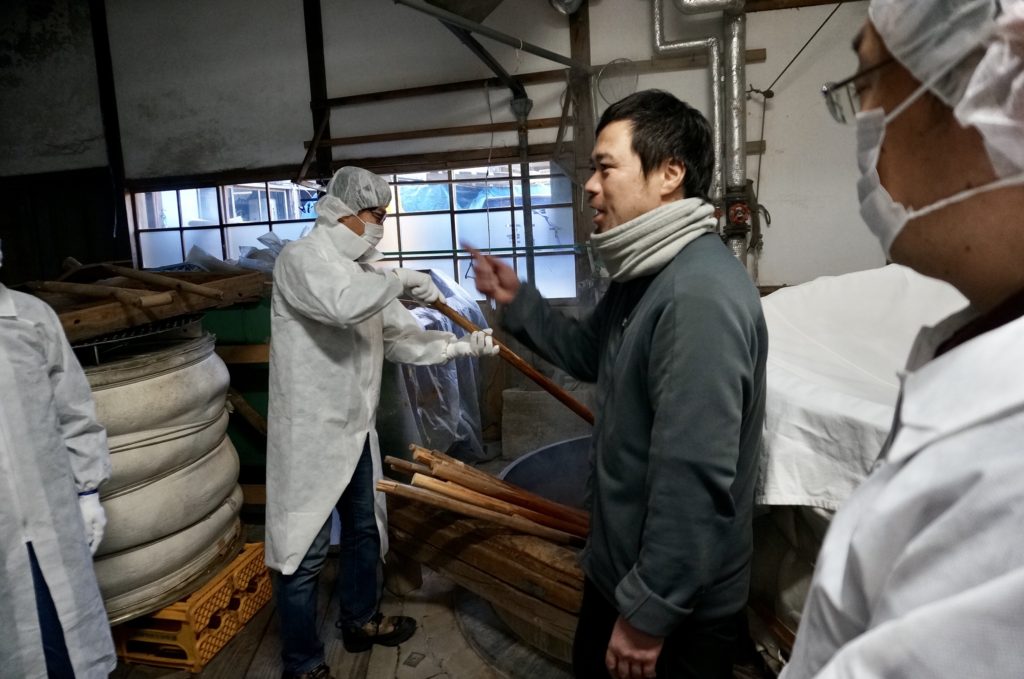
Here is Mr. Morikawa, the toji of this brewery.
Participants are disinfected and wear a white coat, mask and hat. This event is not a special event, but a part of “daily brewing” where people who are related to Morikawa Toji get together to help with the physical work of Yamaoroshi (for fun and experience). There are 20 or so participants and some of them are regulars: one of them said, “This is my third year!”
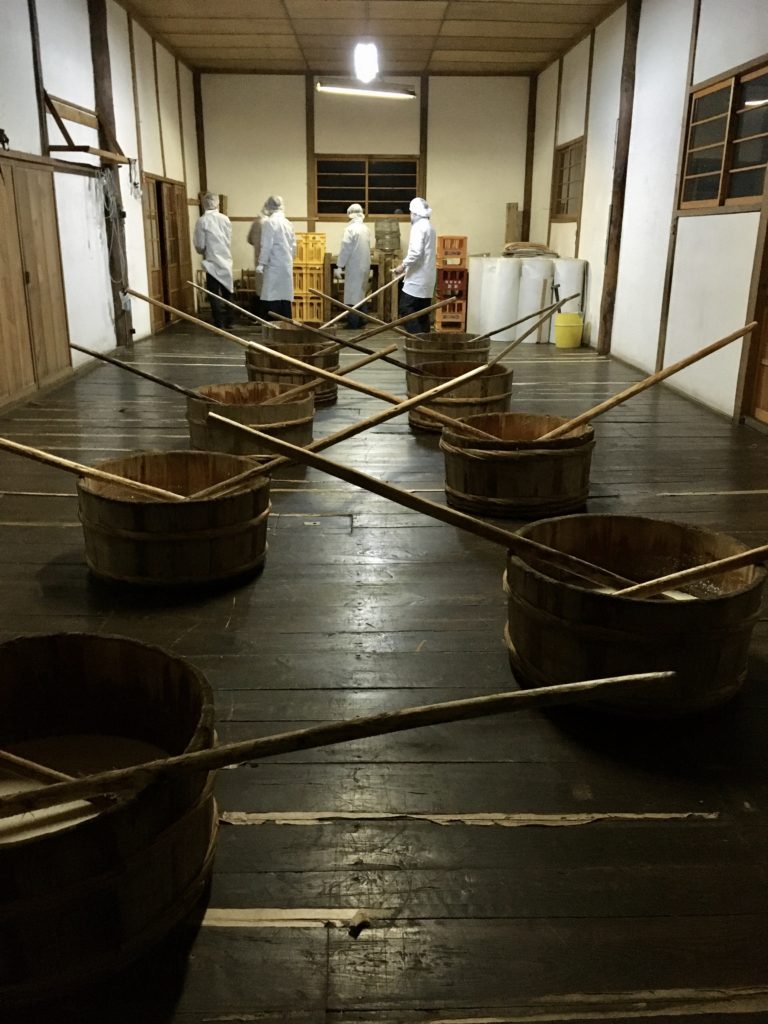
You can see inside the brewery. Barrels are lined up in a row.
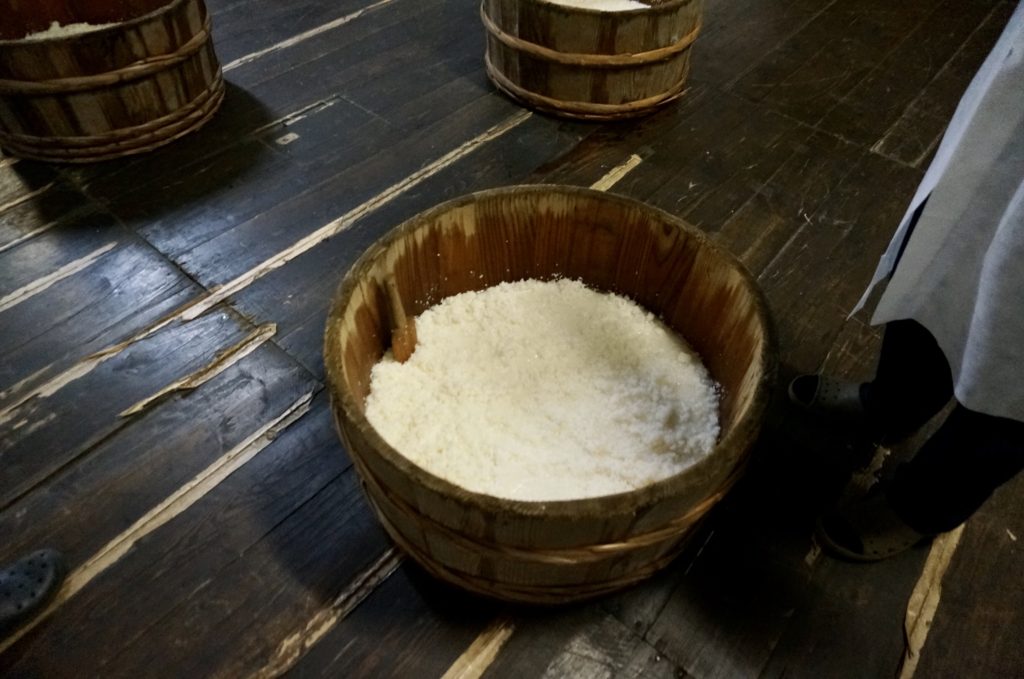
Here’s what’s inside in a barrel. It contains steamed rice, rice koji and water. In pairs, we stand across the barrel and say “One, two, one, two,” while scrubbing the rice with the paddles in unison. One set a few minutes. When one set is finished, we move on to the next barrel and start another set. When we finished going around all the barrels, it took about an hour. We did this twice.
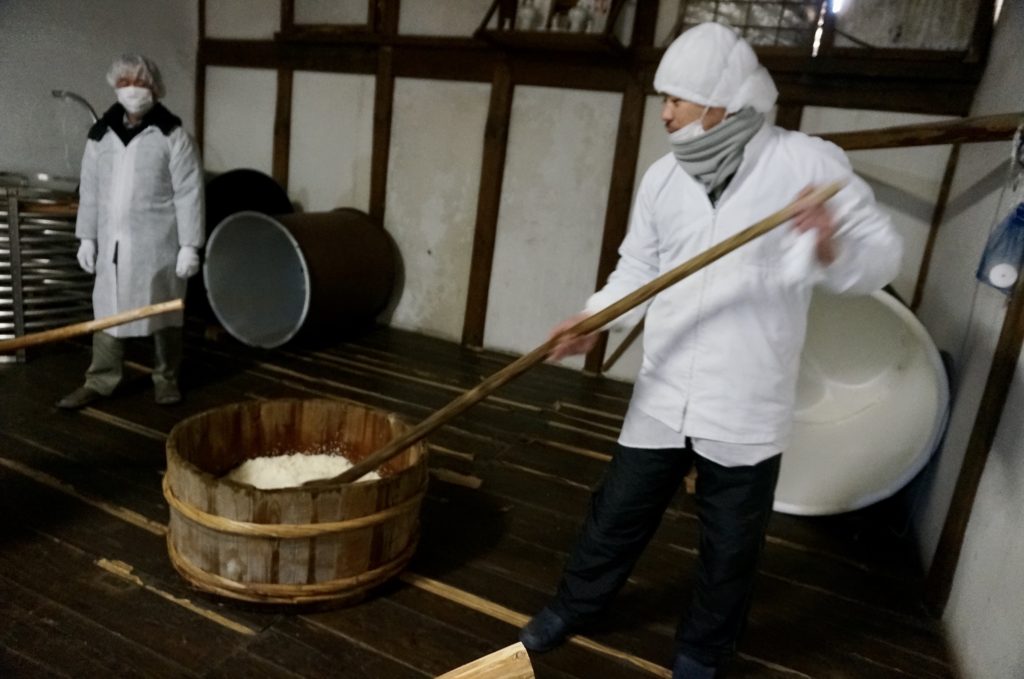
Morikawa Toji did it all by himself once and realized that he couldn’t do it, so he started this kind of participatory Yamaoroshi event.

Now it’s time to start. It’s quite heavy. This is because it’s a large mash mixture of rice and water. You get tired quickly when you use only your arms. I need to put pressure on my lower back.
“Don’t try to crush it strongly. The steamed rice is buried and hardened. Yamaoroshi is not trying to crush the rice. Its goal is to break the rice and get the ingredients inside out.” (Mr. Morikawa)
The trick is to do it “mindlessly”. Pacing yourself by reciting “one, two, one, two” in unison with the motions, you should look at the paddles and rice and just move them.
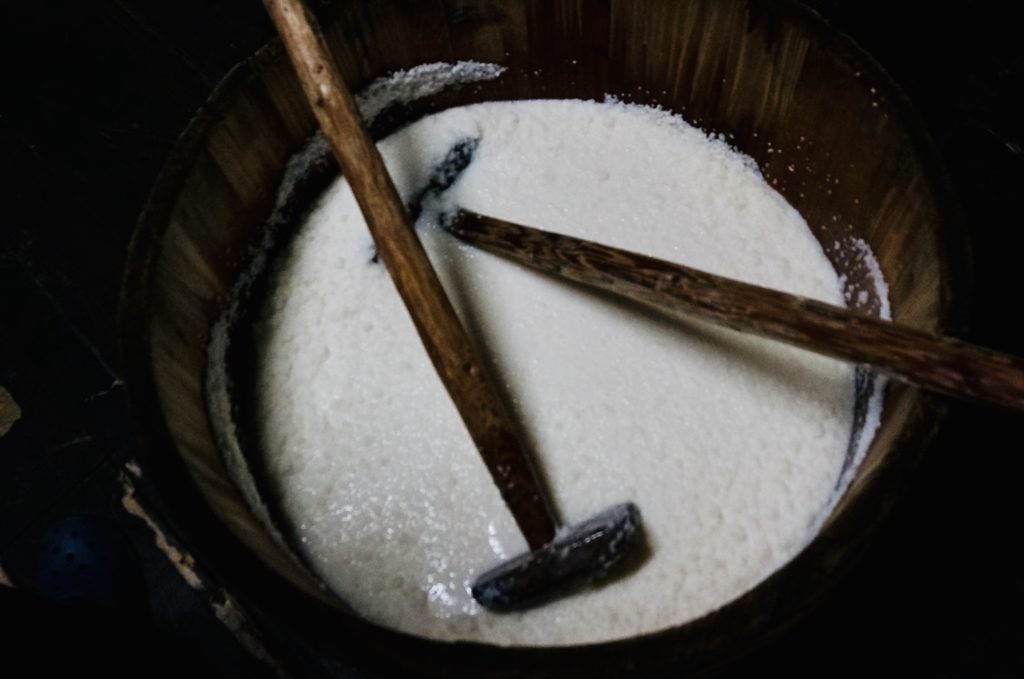
By the end of a few sets, the rice and water will combine well and the texture will be light. It gets so squishy that you have to be careful not to splatter it.
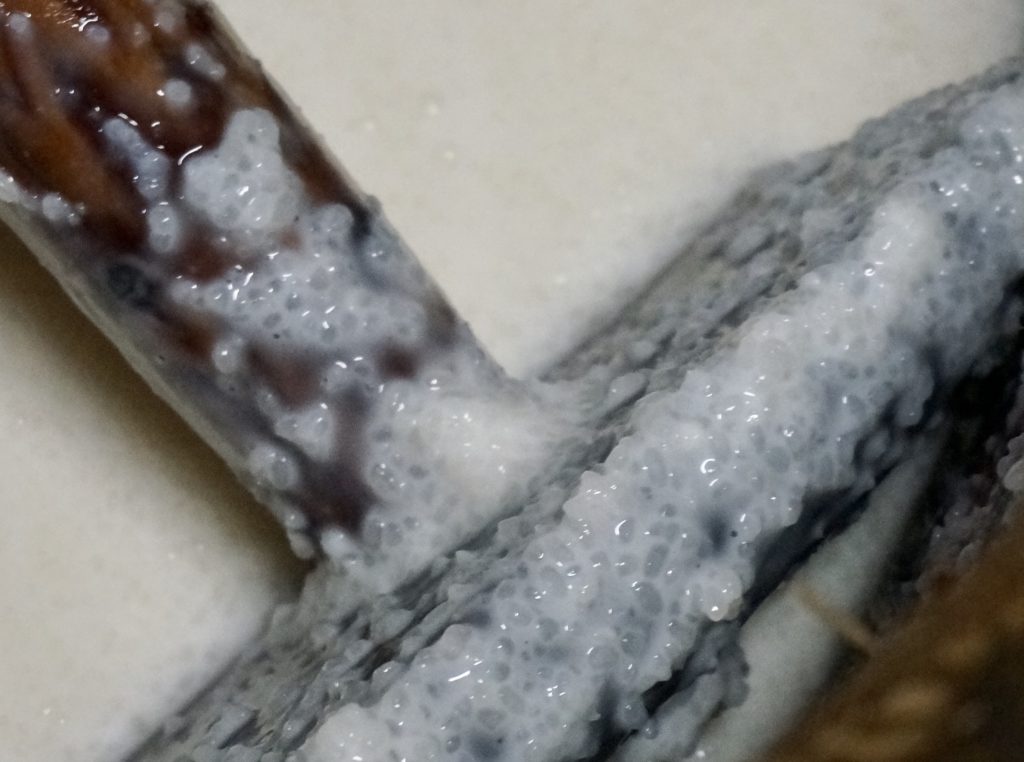
The next time you move to a barrel, however, you feel a kind of stickiness. The type of rice and water content differs depending on the type of sake, but you should be surprised at the difference in variation.
After two hours, I ran out of breath, got sweaty, and my hands got exhausted. It had morphed into something completely different from the first “lump of rice”. Yamaoroshi is amazing.
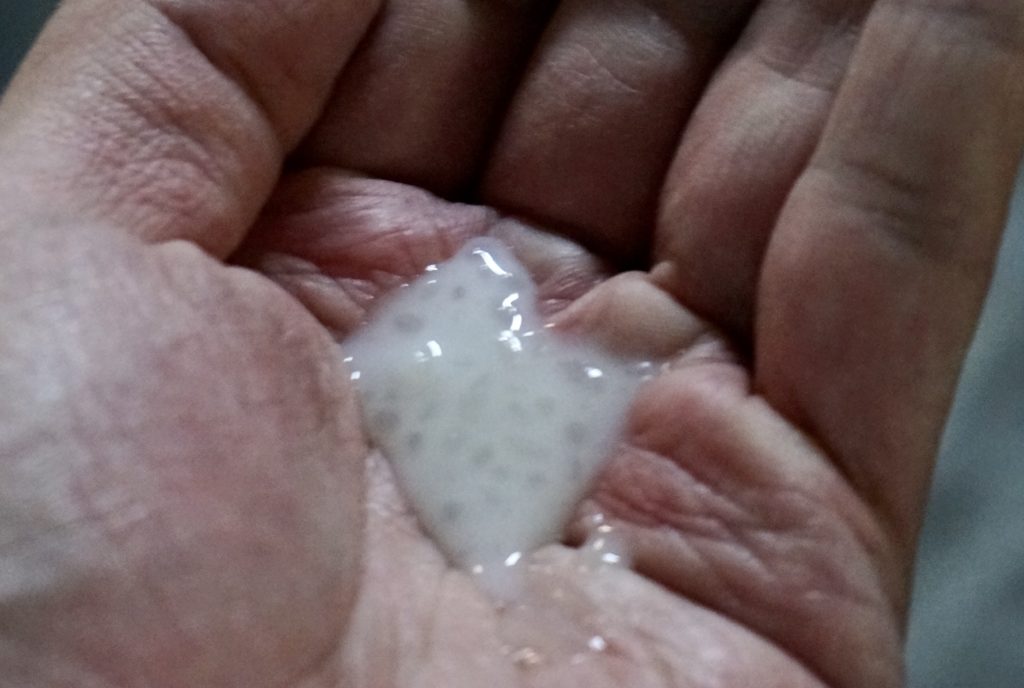
We were allowed to eat some of the rice that had been rubbed. It looks like the type of white tapioca served in Chinese desserts. It has a gentle sweetness of koji, which is delicious.
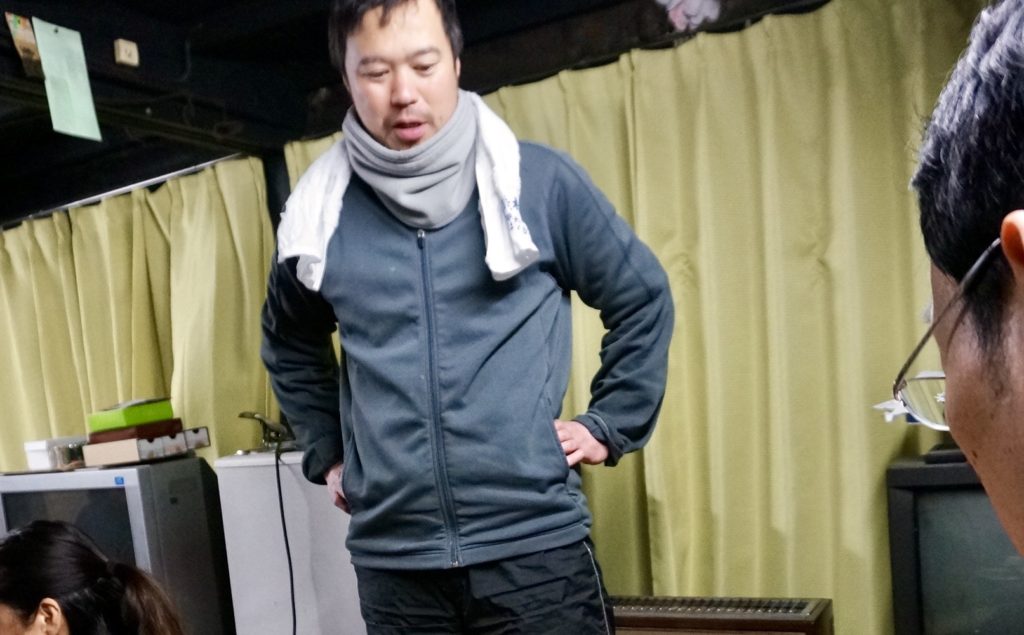
(Nice job!)
Here is a brief introduction to the kind of sake brewing at Syoki Brewery. While there are many different ways of Kimoto (stepping on it with your feet, using a drill, etc.), Morikawa Toji sticks to the classic style.
“I try to recreate the traditional sake brewing process not only with tools but also with water. I get the spring water, and I leave it in the tank for a week or so. For Kimoto, though it’s not a good way to say it, the first thing you need to do is to ‘pollute the water’”. (Mr. Morikawa)
The fermentation of sake requires a variety of bacteria and microorganisms. In today’s too clean tap water, however, the bacteria aren’t even there, so it can’t be an appropriate environment for sake fermentation.
“Kimoto is ‘making clean sake with dirty water.’ Also, we use the dark rice (not high-polished). Nowadays we have clean water and the technology to polish the rice. To put it bluntly, we don’t need to make Kimoto anymore.”
Then why does he work on Kimoto? His answer is “Its flavor.”
“I do it because I want to create a wild flavor. Making it the old-fashioned way gives my sake a unique character.”
The sake made by Syoki Brewery in this way is quite unique. The first time I drank it, I was surprised like, “What the hell is this?” It’s powerful and acidic, but it soaks into your body easily. It’s hard to describe, but it makes you want to have another drink – his sake is such a mysterious drink.
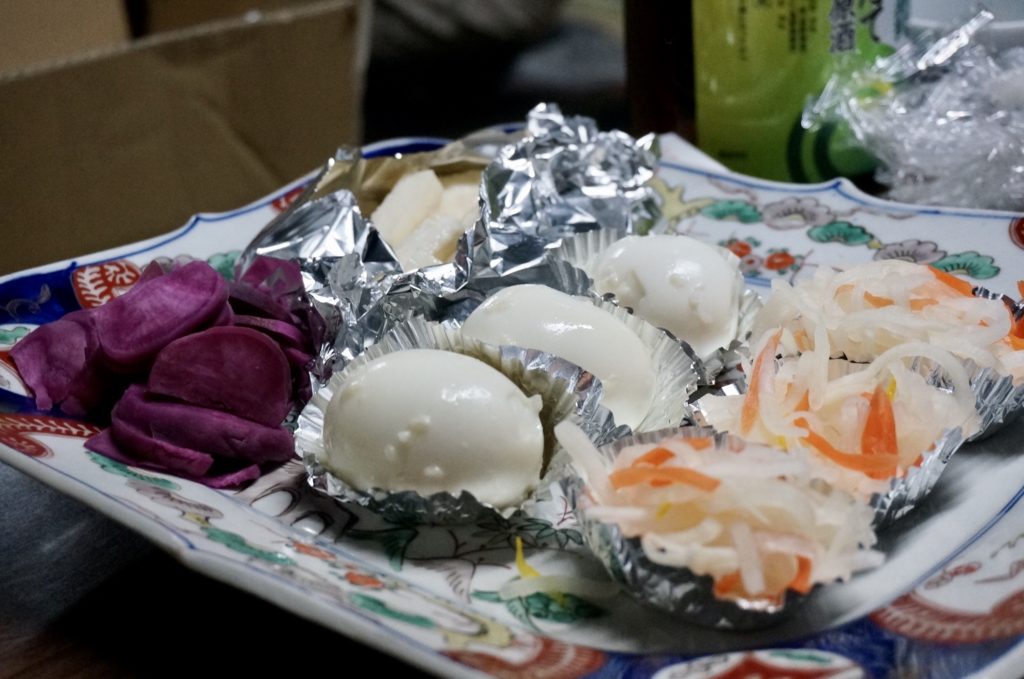
After the sake brewing, we had a party at the brewery. The wife of the president (owner of the brewery) served hand-made “Kura-Meshi (Brewery’s Meal)”. These dishes using the koji from the sake brewery (such as boiled eggs and pickled yam)” are simply delicious.
We paired them with Syoki. It matches so well. Sitting on a zabuton cushion and gulping down sake with an ochoko. Such a great night at the brewery!
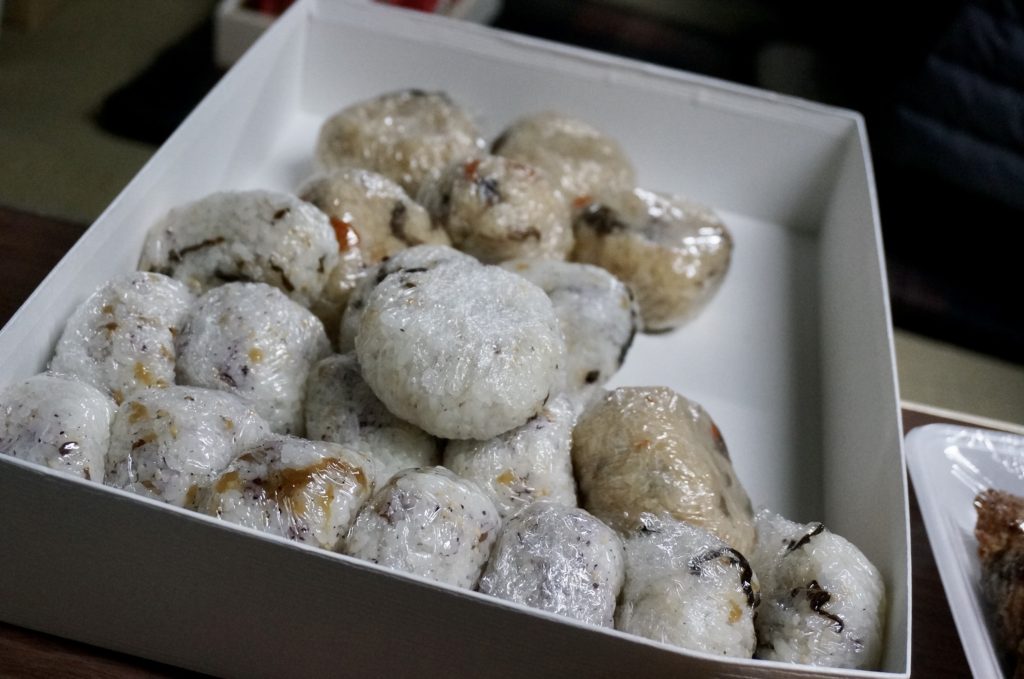
We had nigiri-meshi (a rice ball). I want to call this not “onigiri” but its old name “nigiri-meshi.”
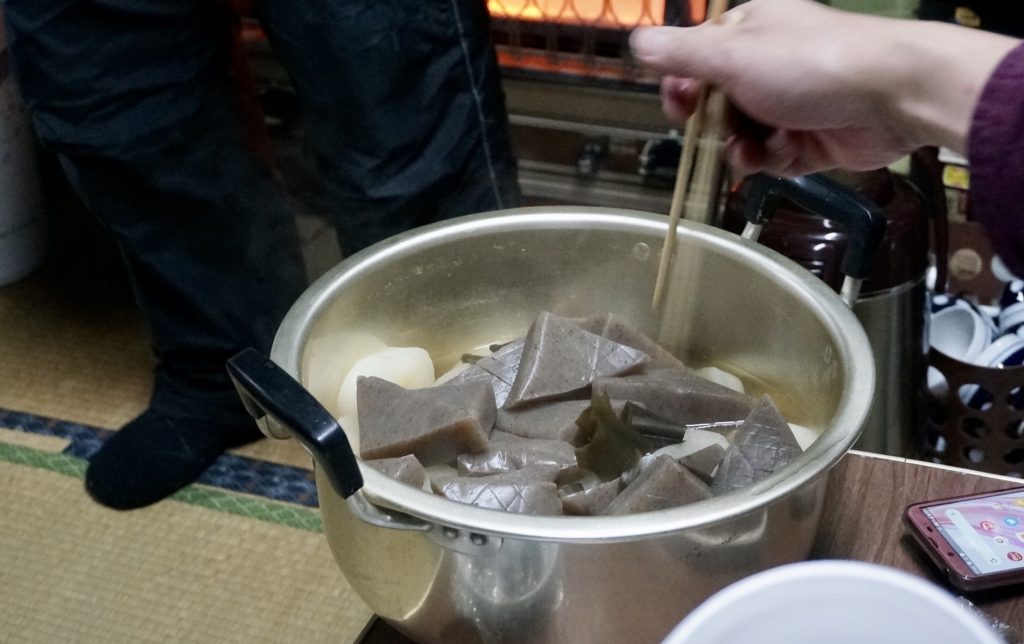
They served oden! Oden in a big pot is amazing. This also goes well with sake.
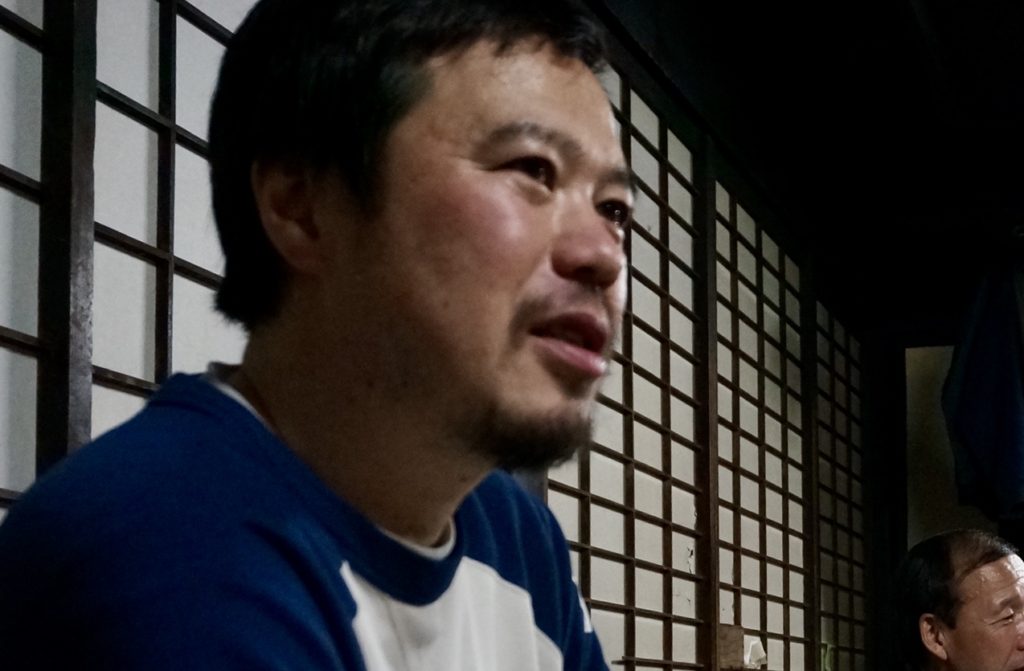
(It’s the most luxurious time to drink sake in the brewery with the people of the brewery.)
Mr. Morikawa says, “I’m usually making sake all by myself, so it’s fun to have such a lively party.” Although they employ part-time workers to join during the busy season, he does almost everything on his own, from cleaning to prep work.
“It’s really quiet in a brewery where I am only the one working, so I can hear the bubbling sound of the sake fermenting. I’m working while thinking that the sake is talking to each other. The current style makes me feel better because I’m free to do everything though.”
Before he came to Syoki Brewery, Morikawa Toji was known as a charismatic toji at another brewery, making “clean sake”.
“I went out of my way (Laugh). Until then, I was making award-winning sake, but now I’m trying to make sake that I wouldn’t even think of entering in a competition.”
One of the examples is “Kikon,” a brand created by Morikawa Toji. Based on the theme of “expressing the acidity of sake”, he creates the series of sake experiments; “Red Label” with malic acid, “Yellow Label” with citric acid, “Black Label” with succinic acid, “White Label” mde with Kimoto method, and “Blue Label with White koji”.
“Sake’s flavor is all about balance. But I wanted to destroy that balance to the hilt. I think this is the strength of an employed toji like me. Because I’m not involved in the management of the brewery, I can swing in the opposite direction of the trends and make products as aggressive as possible.”
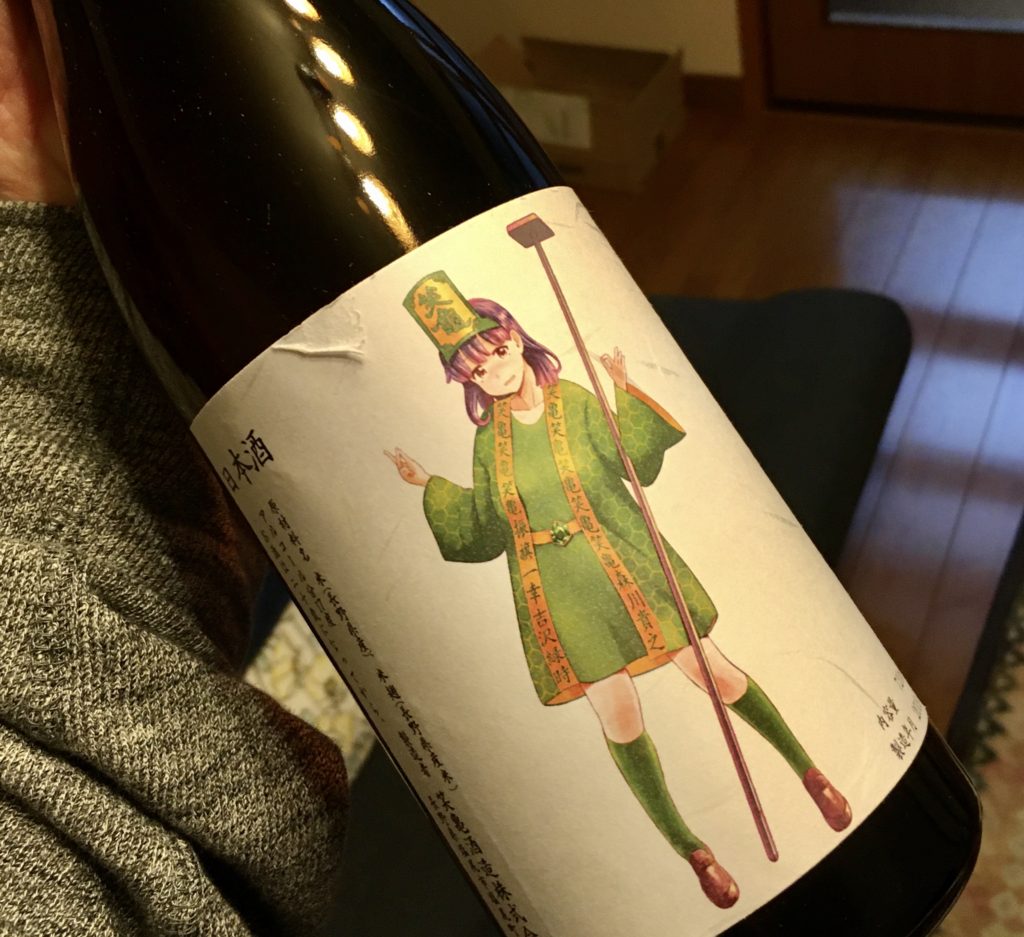
One of the most edgy sake in his products is this one (photo taken at home).
There is no name or description, just a girl character with a touch of animation on its label. It’s actually a massively unique sake made from “miso koji”. The sense of fermentation and flavor is outstanding.
“The reason why I used miso koji is I wanted to strengthen the taste of peptide components that are characteristic of Kimoto. If you’re trying to break down rice protein more powerfully than sake koji, miso koji is clearly the way to go. This would be an unnecessary taste for a general sake. I wanted to bring it to the forefront so that the taste that gets in the way isn’t a hindrance.”
……I’m not sure about the details, but sounds great.
“FYI, the reason why it doesn’t say anything on the label is a gap effect. Her name is “Misono-chan” because this sake is made with miso koji. She’s actually the second of three sisters. I am planning to make her sisters. Eventually, I will make the three idols of the Miso Koji Sisters……”
He talked about his idol concept with the most enthusiasm of the day.
I love the way he holed himself up in a brewery in Nagano Pref. to work on his own original creations that ignore the trends in the sake industry, while he seriously talks about his idol concept.
And most importantly, his sake is delicious. It’s not just a simple deliciousness. You can experience powerful, wild and “living” feelings.
I was made aware that there is not just one path but dozens and dozens of different routes to drink and like it.
Mr. Morikawa, I’m looking forward to seeing the Miso Koji Sisters! Mr. Kodama, thank you for your guidance!